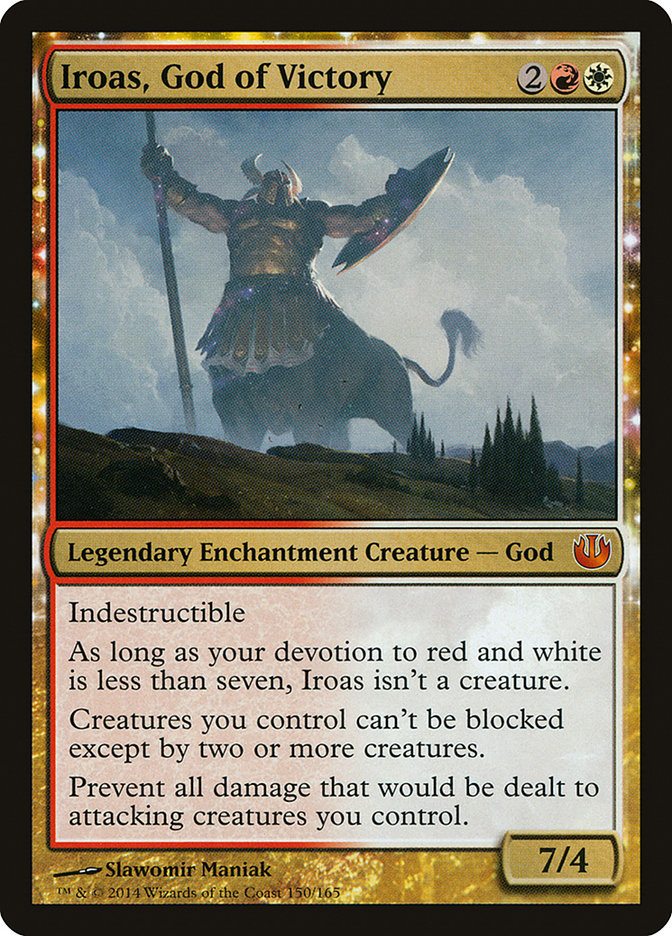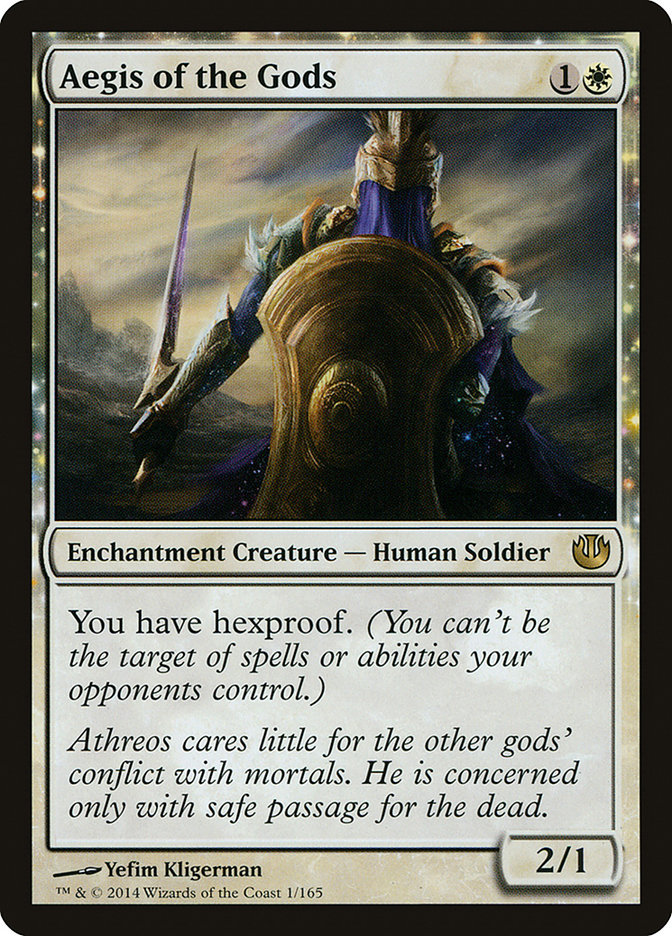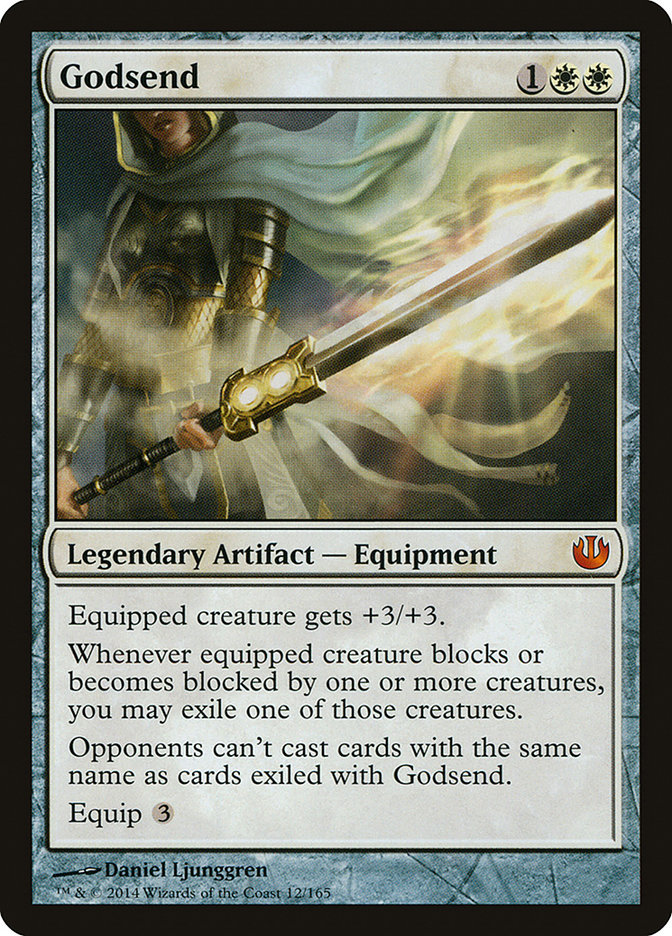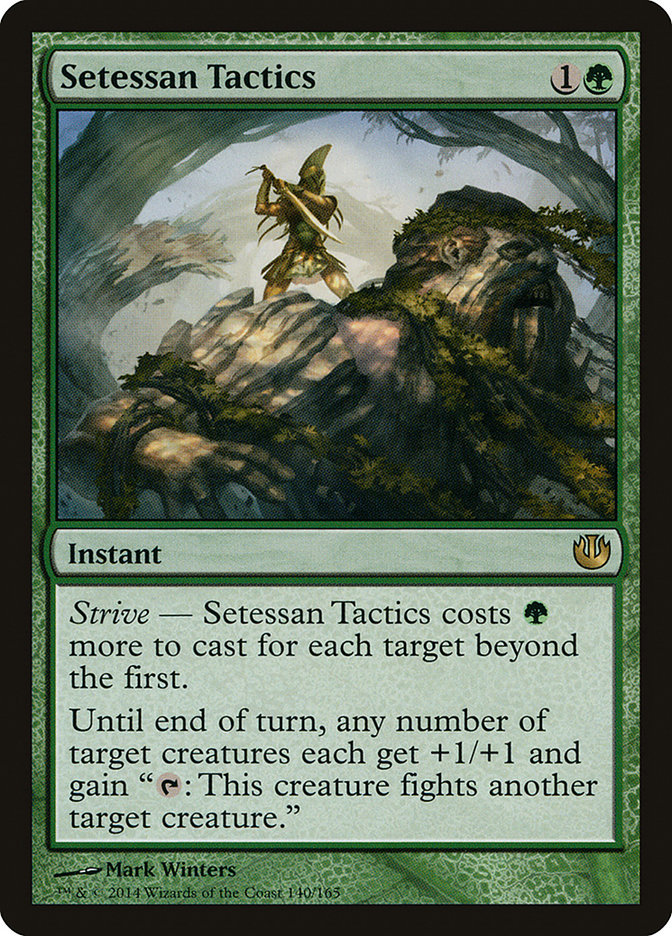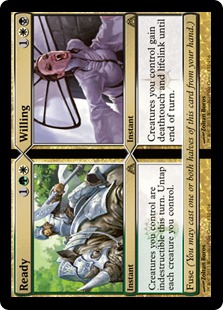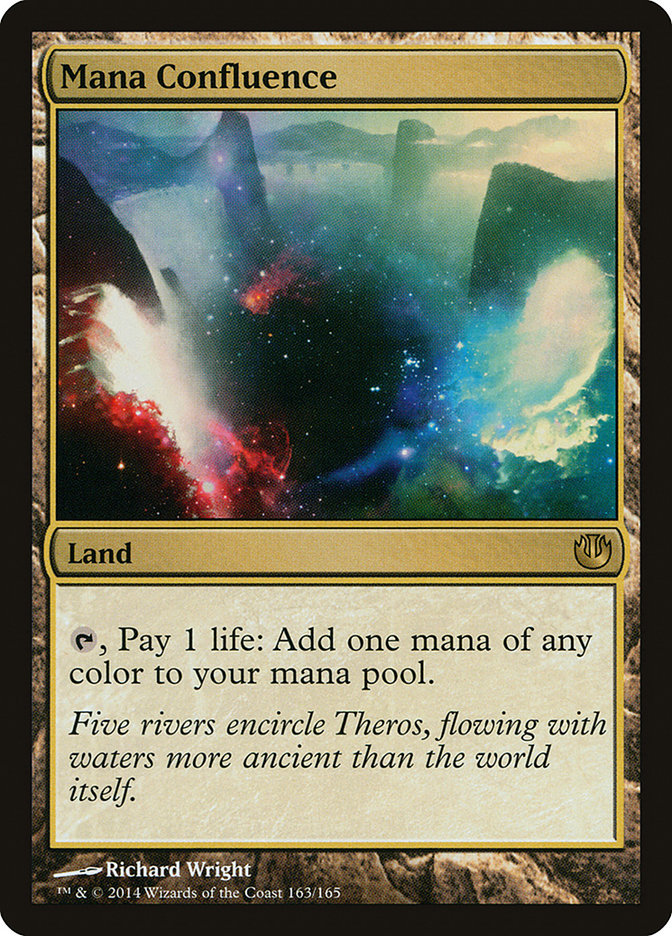Born of the Gods has had three months to make an impact on Standard, and it seems that it has had little. Grand Prix Phoenix was the final Standard premier event of the season, and fourteen of the Top 16 decks were blue devotion, black devotion, and Sphinx’s Revelation control. These same three archetypes dominated the scene almost six months ago, which has led Standard to feel quite stale.
Journey into Nyx will be released in two weeks and is the final set in Theros block. Official previews have begun, and it seems the new set has the potential to address the root problems that prevent new decks from competing. Today I’ll go over five cards that have piqued my interest, evaluating their potential uses and seeing if any of them can create new archetypes rather than complement existing ones.
Iroas, God of Victory
There are lots of effects on Iroas, God of Victory, but they’re not new ones. Goblin War Drums’ most recent iteration, Gruul War Chant, has been legal for ages and has gone mostly unplayed. Frontline Medic has similar damage prevention for attacking creatures and is similarly ignored. Putting both of these abilities on the same card still would not make me want to play it in any deck, so the question remains whether the creature aspect is viable.
Accumulating seven devotion for Iroas to attack for seven is not as easy to do as other Gods. Removal is plentiful in Standard, so getting assistance from some noncreature permanents helps enormously. Ephara, God of the Polis has Detention Sphere; Thassa, God of the Sea has Bident of Thassa; and Erebos, God of the Dead has Underworld Connections. Chained to the Rocks is certainly good but is only available in a base red build. A red build centered on creatures and devotion would benefit far more from Fanatic of Mogis’ speed or Purphoros, God of the Forge for reach while playing defense. Using white as a base instead of red opens up Lifebane Zombie as a huge liability.
Iroas does not work well with his premier devotion enabler Boros Reckoner. Forcing a double block to prevent the Reckoner from hitting enemies is great, but preventing damage to attacking creatures is most decidedly not. Gray Merchant of Asphodel; Desecration Demon; Brimaz, King of Oreskos; Frostburn Weird; Master of Waves; and Courser of Kruphix are all creatures big enough to battle and live, stopping the Reckoner from doing guaranteed damage.
Iroas seems to be aiming for a format that just does not exist. Mono-Black Devotion and U/W/x Control both excel at removing creatures, rendering his combat-only ongoing effects irrelevant. Mono-Blue Devotion can ignore Iroas by forcing the R/W player on the defensive with fast evasive threats or one-shot killing with Master of Waves.
Aegis of the Gods
Hexproof is a powerful ability on creatures, but players having hexproof is quite rare. There are only two decks in Standard that would be hindered greatly by Aegis of the Gods: Mono-Black Devotion and R/W Burn. Mono-Black Devotion has Thoughtseize, Devour Flesh, and Lifebane Zombie, while R/W Burn has Boros Charm, Skullcrack, and Toil // Trouble. Sadly, removal such as Bile Blight, Hero’s Downfall, Searing Blood, and Chained to the Rocks are also in these decks, so invalidating huge swaths of the opponent’s deck seems unlikely. The only way for Aegis of the Gods to truly shine is for the opponent to not have any way of killing it at all, and there are two decks that can accomplish this feat: U/W/x Control and Naya Hexproof.
Sphinx’s Revelation decks can board in Aegis of the Gods against Mono-Black Devotion. Duress; Erebos God of the Dead; and Lifebane Zombie are commonly sideboarded in over nearly all the removal sans one or two copies of Devour Flesh (to deal with Blood Baron of Vizkopa) and Hero’s Downfall (which really only has Elspeth, Sun’s Champion as a target). Landing a turn 2 Aegis can not only protect your hand from disruption but also lessen the life available to Underworld Connections and Erebos.
R/W Burn would need to spend to hit Aegis of the Gods before killing you, turning it into a pseudo Lone Missionary, which is exactly the type of card you are looking to board in for dead removal spells.
However, the most attractive way to use Aegis of the Gods is placing it in the sideboard of Naya Hexproof. Thoughtseize, Lifebane Zombie, and Devour Flesh are truly huge problems that are solved, as it is highly unlikely any targeted removal spells remain in sideboarded games. Sadly, Gray Merchant of Asphodel does not target players, so hexproof will not save you from buying what he is selling. R/W Burn is heavily reliant on Skullcrack to prevent a game-winning Unflinching Courage swing, something that Aegis of the Gods is happy to help stop. And let’s not forget that Ethereal Armor is slightly buffed because Aegis of the Gods is randomly an enchantment.
Godsend
Equipment does not run the risk of getting two-for-oned like normal enchant creatures but does still have vulnerability to removal. Spending seven to nine mana (three to play, three to equip, some amount of mana spent on whoever is holding it) is an extremely high price to pay to walk into Hero’s Downfall, Azorius Charm, or Doom Blade. This type of exchange is called a tempo play—a player spends far less mana to stop or remove something, gaining the ability to spend that saved time and mana to further their own plan to win. Standard decks can use that extra four to six mana "gained" by stopping a card like Godsend to cast Divination; Jace, Architect of Thought; Sphinx’s Revelation; or Underworld Connections, giving them the ability to have your future plans with Godsend meet a similar fate.
Godsend has some really strange abilities not often seen on a card, so to put it into a proper perspective let’s simplify the text. Here is a sample of what Godsend might actually read during a game:
1WW
Legendary Artifact – Equipment
Equip: 3
Equipped creature gets +3/+3 and is unblockable.
Be aware that the above card is likely miles better than Godsend’s actual text, as they can certainly toss a creature away to prevent the damage if they so choose. Godsend is much more Vulshok Battlegear than any of the Mirrodin block Swords like Sword of Fire and Ice.
White has a lot going on at the three-drop slot with Brimaz, King of Oreskos; Ajani, Caller of the Pride; Boros Reckoner; Spear of Heliod; and Banisher Priest. Godsend does not really offer something that other cards do not do better, and I would venture to say that another card in Journey into Nyx, Dictate of Heliod, does Godsend’s job better.
Setessan Tactics
Setessan Tactics gives green decks access to direct creature removal far above any they have had before. Domri Rade and Pit Fight are red, which make them unable to target Master of Waves. Time to Feed and Hunt the Weak are sorceries that are way too expensive, and Mutant’s Prey is far too limited in scope. Consider the following common examples from Standard—best of all is its ability to two-for-one or better, something green decks are in dire need of.
Example A
Villain opens with Frostburn Weird, Nightveil Specter, Master of Waves on the play.
Hero has Sylvan Caryatid, Courser of Kruphix on the draw.
Hero is in dire straits, facing down an overwhelming board with Domri Rade ineffectual and Polukranos World Eater being too slow. Three mana for Setessan Tactics on Sylvan Caryatid and Courser or Kruphix allows the removal of both Nightveil Specter and Master of Waves, turning around a nigh unwinnable game.
Example B
Villain opens with Pack Rat on the play.
Hero has Elvish Mystic, Scavenging Ooze on the draw.
The bane of many a green deck is the accursed Pack Rat. Setessan Tactics on turn 3 (after a Pack Rat activation end of turn) cleans up the mess that would almost always be an auto loss.
Setessan Tactics seems like it could be a Constructed staple similar to Mizzium Mortars. Granting +1/+1 in addition to the fight ability makes it have huge utility as a simple combat pump or even as a way to push through the last points of damage in creatureless matchups, something Mizzium Mortars has always had a weakness to. Courser of Kruphix works wonderfully in promoting a board stall and even provides you with enough mana to make sure nothing escapes.
Ready // Willing is a card that was completely outclassed by Rootborn Defenses until now. Consider the following line of play:
- Cast Setessan Tactics on your creatures.
- Activate the fight ability on all of your creatures without passing priority.
- Respond to the final fight activation with Ready // Willing.
The reason for that sequencing is that you want your creatures to have indestructible, deathtouch, and lifelink before any of the fights resolve. Most importantly, you need your creatures tapped so that Ready untaps them. After the bloodbath you have a horde of untapped lifelink creatures with +1/+1 that you can attack with . . . or have them fight each other. Lifelink is the reason to do this, as with all your critters acting like The Three Stooges you’re gaining twice the amount of life you would get by merely attacking.
Constructing the board state on how any of this could occur against a conscious opponent who is trying to win is difficult since this is a ton of mana to pull off. Creatures that are cheap that produce multiple mana like Gyre Sage or token generators like Elspeth, Sun’s Champion would be involved. This may even allow a new deck type to emerge with Boros Reckoner, as it loves fighting with Setessan Tactics and having indestructible and lifelink allows the trigger targeting itself to gain an arbitrarily large amount of life.
Mana Confluence
The one card most responsible for any deck becoming viable in the next three months will be Mana Confluence.
Mana Confluence has far too high a cost to be played solely for Nightveil Specter in Mono-Blue Devotion, and Mono-Black Devotion already uses its life total with Thoughtseize and Underworld Connections. Sphinx’s Revelation decks utilize their life total as a resource to ignore the opponent until late game, so they also will not be using Mana Confluence as any more than a one-of.
One of the established decks that gains the most from Mana Confluence is G/B Dredge. Thirteen green sources is abysmally low for a deck that has to mulligan every hand without one, and cobbling together two black off of eleven Swamps is also difficult (even with green helping). Bumping those numbers up to seventeen and fifteen removes one the deck’s greatest obstacles from winning: itself. Deathrite Shaman, Whip of Erebos, and just being really fast are all options to offset the life loss.
Naya Hexproof is another archetype that needed an untapped tri-color land badly. Gladecover Scout into Madcap Skills into Ajani, Caller of the Pride is nearly impossible with only shock lands and Temples. The life loss incurred is negated in one hit by Unflinching Courage and Fiendslayer Paladin, spells you might actually be able to cast in a reasonable manner now.
Iroas, God of Victory and Godsend are unwanted effects and are unlikely to have an impact on Standard. Aegis of the Gods is not resilient enough to be a maindeck card, but it is a powerful sideboard card that will definitely affect a few matchups. Setessan Tactics will find room in every base green creature deck, providing new interactions and situations they normally would not have. Finally, Mana Confluence massively boosts G/B Dredge and Naya Hexproof while providing nearly nothing for Mono-Blue Devotion, Mono-Black Devotion, and U/W/x Control.
Are Iroas, God of Victory and Godsend better than they seem? Is Setessan Tactics the new green Mizzium Mortars? What deck gains the most from Mana Confluence?

